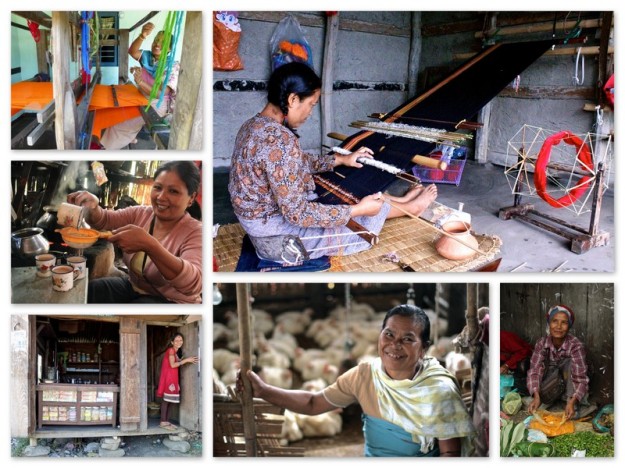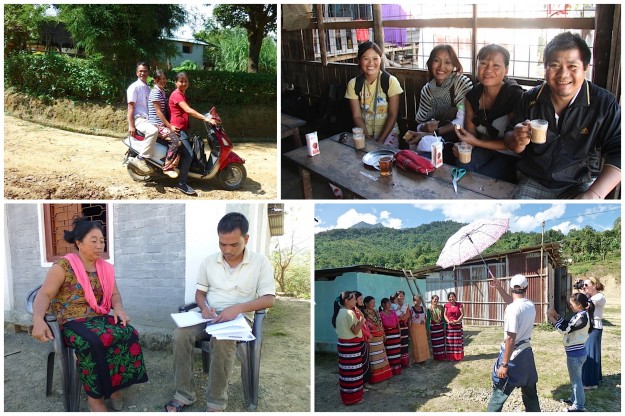Chai Breaks in Odisha & Manipur (Part II)
November 30, 2012
By Eileen Flannigan | KF19 | India
Eileen and Irene are both fellows in India. Eileen is living in Imphal, Manipur and Irene is in Bhubaneswar, Odisha. While in conversations with one another, we have been struck by how different the cities are. We’ve compiled these observations to share with you our experiences of the rich and diverse culture of India. Eileen’s profiled in Part 2 below, while Irene is featured in Part 1.
Top 3 things that you notice while roaming your neighborhood?
To some degree, Imphal looks like most Indian cities; colorful clothes laid out on riverbeds, vibrant vegetable vendors, cows grazing in busy streets, sidewalk barbers and active “hotels” (i.e. shops) of meat, rice, and tea. However, on closer investigation, my curiosity led me to these:
- Rickshaw drivers in disguise. I was perplexed why most of the rickshaw drivers were covered from head-to-toe with only eyes showing, even on very hot days. I learned that these educated young men were forced to take this job because of the high unemployment in this region. It’s considered an act of shame for themselves and their families if their identity was known.
- Men with large guns. Sadly, this has been a hotbed for militancy for decades. At any given moment, I’ll see men in combat uniforms jammed into the back of a vehicle or a crew taking a break at a paan shop or a tank slowly cruising down the street with the watchman’s bust out the top.
- Kids in uniform. I live right across the street from a primary school and my favorite morning ritual is to watch them all gather with the last bit of wild exuberance before the subdued day ahead. Children arrive scrunched with siblings on bikes, rickshaws, or father’s shoulders. Sisters eagerly tie younger one’s bows, friends connected by sweet hand holding and boys arm and arm while imitating their favorite cricket bowler.
When you want the “comforts of home” experience, what do you do?
I live with a family that has two young boys, so I’ve taught them some American card games like Go Fish, Slap Jack and Crazy Eights. On chilly nights we obsessively play with gusto, which always makes me happily nostalgic.
Although, when I’m really longing for home, I head to the best hotel in town to have a cappuccino and baked yogurt, which is a newly delicious discovery that is a cross between a crème brûlée, and American style yogurt. Although I appreciate the ritual and social nuances of chai time, there’s nothing like the comforts of a cup of coffee or two, to turn my day around. Added bonus is this cafe plays the most wonderfully bad acoustic remakes of American songs. Depending on my mood, I am either really happy or deeply embarrassed that I now know all the lyrics to Rhinestone Cowboy.
Describe the people and culture in your region.
Manipur is one of the most northeastern states of India, snugly positioned next to Myanmar, formally known as Burma. Almost all states in the northeast have international borders with countries that include Nepal, Bhutan, Bangladesh, Myanmar and China which has meant a continuous migration of people with strong ethnic identities. The amalgamation of different tribal nations, indigenous traditions, languages and food has left a dynamic imprint on the Manipuri culture. They have a rich arts heritage, however my favorite pastime is the daily theatre of weaved garments whisking by in the streets, with just the right amount of dramatic flair. Most women don’t wear saris but a long wrap-around skirt that tell a story of the woman, her home tribe and religious lineage through the intricate patterned design, electrified colors and weave techniques.
I love Indian food and its explosion of spices to awaken an exotic, far-away feeling in me. However, one of my biggest surprises has been with my culinary experiences. It’s not your typical Indian fare of masala, cardamom, coriander and the like, with the exclusion of turmeric, spices are used minimally here, if at all. Manipuris smother everything with the king chili (the hottest in the world) and say that “rice is always the main course” with something fermented (fish or bamboo) and possibly dried meat as a side. Thankfully, my host family has been understanding of my western palette and doesn’t try to push the king chili on me, as I think we both know it would end badly.
What type of work is common in this region for Kiva borrowers?
I’ve been awed by the way Kiva borrowers work many different, inter-connected businesses to sustain their livelihoods. There is no main industry to speak of, so the women must find creative ways to bring in little bits of income from many different sources, mostly 4, 5 or even 6 businesses operating at once. The Kiva borrowers, all women, live in remote hill areas with fertile land and weaving skills that start at a very young age and are seeded in deep traditions. They are using these strengths to form business of:
Weaving + Rice Paddy + Garden
All village women will be involved in these three activities. Weaving is done twice daily, at dawn and late night when all the other household chores are completed. Rice harvesting is only once a year and the yield is not only expected to feed the whole family throughout the year but provide a small supplemental income. A majority of families, regardless of income level, have a paddy field that has been pasted down through the generations. In addition, village families will have anything from a kitchen garden to a full farm. In this region, they typically grow potatoes, gooseberries, ginger, turmeric, cabbage, chillies and will use the harvest for family consumption and market sales.
Piggery + Poultry
“Piggeries”, as pig farms are known here, can reap a good profit, especially around festival time when the demand is high. Ladies will spend about 8-9 months feeding their pigs from scraps from their garden and rice paddies. In most cases, a woman who is raising pigs will be raising chickens,too. This is because chickens, like pigs, are a home based business and can be sold within 4-6 weeks, allowing the Kiva borrower profit to live and pay back the loan while waiting for the income from the piggery.
Clothing +Tea + Paan+ Variety Stores
The resale of used clothing has provided a good living for Kiva borrowers here because of the high profit margins with less time and hard labor then other activities. In addition, tea stalls, paan shops and variety shops are heavily littered throughout India, but in rural areas they are still viable means to respond to village needs.
What are the main strengths of your MFI and how have you experienced these in the field?
Kiva’s partner, WSDS-Initiate, has many strengths that contribute to successfully penetrating the remote regions in the northeast. Manipur has several challenges and complexities that make it difficult for financial institutions to operate. Which of course, compound the effects of social, political, and geographic circumstances by widening the disparities in rural populations by financial exclusion. WSDS- Initiate, has a long history of working in this area, not only in a financial role but a social services capacity and understands the ethnic conflicts and nuances needed to work with many different tribal communities. They operate with an inclusive approach that tribal harmony and peace-building is pivotal to the regions long-term growth. Therefore, they work with the three major tribes (Kuki, Naga & Meitei) in remote and sometimes dangerous regions with a needs-based approach to financial inclusion. This includes, not only providing loans, but financial training and savings education. I’ve personally met hundreds of WSDS clients, in several villages and have witnessed how they work to financially include and educate all women, even those that are considered “too high risk”, such as widows, women over 55 years old and those with little collateral.
In addition, I’ve been particularly inspired by how they continue to strive to make a social impact in this region, which isn’t easy. They have partnered with organizations that are using innovative ways of enhancing their client’s livelihood activities by enabling them to get better access to solar power, education, agriculture and forestry projects that benefit the whole community. It’s clear that WSDS’s investment in these villages are holistic with the overarching driving principle of poverty alleviation.
Eileen Flannigan is a Kiva fellow (19th class) serving in Manipur, India with the micro finance organization, WSDS Initiate. Support our Indian partners here, join the Indian lending team, WSDS lending team or get a holiday gift card for someone special!
PREVIOUS ARTICLE
New Field Partner: Expanding opportunity for students with Vittana →NEXT ARTICLE
New Field Partner: AgDevCo helps small scale farmers do big business →


















